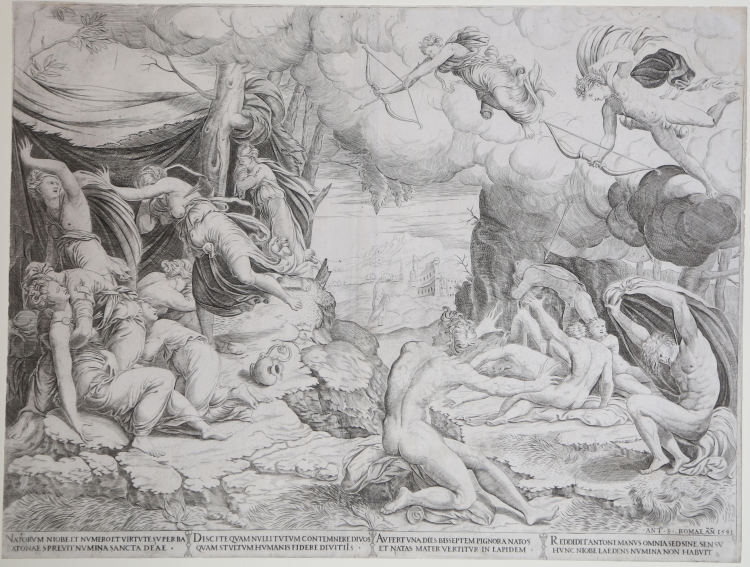



| Reference: | S36156 |
| Author | Nicolas Beatrizet detto BEATRICETTO |
| Year: | 1541 |
| Measures: | 445 x 340 mm |


| Reference: | S36156 |
| Author | Nicolas Beatrizet detto BEATRICETTO |
| Year: | 1541 |
| Measures: | 445 x 340 mm |
Engraving, 1541, dated and inscribed with publisher's address and date lower right: 'ANT. S. ROMAE 1541'. Second state of three, with Salamanca’ address.
In the margin 'NATORVM NIOBE ET NVMERO ET VIRTVTE SVPERBA/LATINOAE SPREVIT NVMINA SANCTA DEAE//DISCITE QVAM NVLLI CONTEMNERE DIVOS/QVAM STVLTVM HVMANIS FIDERE DIVITIIS//AVFERT VNA DIES DISSEPTEM PIGNORA NATOS/ET NATAS MATER VERTITVR IN LAPIDEM//REDDIDIT ANTONI MANVS OMNIA SED SINE SENSV/HVNC NIOBE LAEDENS NVMINA NON HABVIT'.
Good impression, printed on contemporary laid paper with “eagle crowned in the circle”, trimmed close to platemark, central fold visible, otherwise very good condition.
The subject of this engraving is taken from Ovid’s Metamorphoses (VI, 146-312): Apollo and Diana killed the Niobe’s seven daughters and seven sons, for the insult offered to their mother Leto by Niobe, who claimed that her children were superior to Diana and Apollo.
The composition relates to a drawing attributed to Francesco Salviati in the Ashmolean Museum (Oxford, inv. no. 682).
According to Massari, the style and technique of this engraving, frequently attributed to Giulio Bonasone, has no relationship with any signed print of the artist and is closer to the engravings of Beatrizet, in particular his Death of Meleager (Bartsch XV.260.41).
|
Bartsch XV.42.13; Massari, Giulio Bonasone, no. 4; Cirillo Archer in TIB 1995, 2801.049.
|
Nicolas Beatrizet detto BEATRICETTO Thionville 1515 circa - Roma 1565
|
Nicola or Niccolò Beatricetto, or Beatrice or Beatici or Beatricius or Nicolas Beatrizet Lotharingus according to the original name, was born in 1515 in Thionville, in the French region of Lorraine. He worked as drawer and engraver. He moved to Rome between 1532 and 1540 to study in the studio of Marcantonio and Agostino Veneziano. From the very beginning, he showed his peculiar sense of equilibrium for lines, shadows, tones and he became the leader of foreign engravers and artists in Rome. Under the influence of Agostino Veneziano and Giorgio Ghisi, Beatricetto picked up Raphael and Michelangelo as models for his work.
He worked for Salamanca (1540-1541), for Tommaso Barlacchi (1541-1550) and Lafrery (1548) who eventually added some of his work to his Speculum.
He essentially engraved reproductions of famous works, with sacred scenes and mythological subjects, buildings and palaces of his times. He died in Rome in 1565.
The states of the second half of XVI century bear the names of Claude Duchet and heirs, Paolo Graziani, Pietro dè Nobili; in the XVII century those of Giovanni Orlandi, Philippe Thomassin, Gio.Giacomo dè Rossi “alla pace” and Giovan battista dè Rossi “a piazza Navona”; in the XVIII century that of Carlo Losi.
Bartsch lists 108 prints under his name, Robert-Dumesnil 114 and Passavant 120.
|
|
Bartsch XV.42.13; Massari, Giulio Bonasone, no. 4; Cirillo Archer in TIB 1995, 2801.049.
|
Nicolas Beatrizet detto BEATRICETTO Thionville 1515 circa - Roma 1565
|
Nicola or Niccolò Beatricetto, or Beatrice or Beatici or Beatricius or Nicolas Beatrizet Lotharingus according to the original name, was born in 1515 in Thionville, in the French region of Lorraine. He worked as drawer and engraver. He moved to Rome between 1532 and 1540 to study in the studio of Marcantonio and Agostino Veneziano. From the very beginning, he showed his peculiar sense of equilibrium for lines, shadows, tones and he became the leader of foreign engravers and artists in Rome. Under the influence of Agostino Veneziano and Giorgio Ghisi, Beatricetto picked up Raphael and Michelangelo as models for his work.
He worked for Salamanca (1540-1541), for Tommaso Barlacchi (1541-1550) and Lafrery (1548) who eventually added some of his work to his Speculum.
He essentially engraved reproductions of famous works, with sacred scenes and mythological subjects, buildings and palaces of his times. He died in Rome in 1565.
The states of the second half of XVI century bear the names of Claude Duchet and heirs, Paolo Graziani, Pietro dè Nobili; in the XVII century those of Giovanni Orlandi, Philippe Thomassin, Gio.Giacomo dè Rossi “alla pace” and Giovan battista dè Rossi “a piazza Navona”; in the XVIII century that of Carlo Losi.
Bartsch lists 108 prints under his name, Robert-Dumesnil 114 and Passavant 120.
|